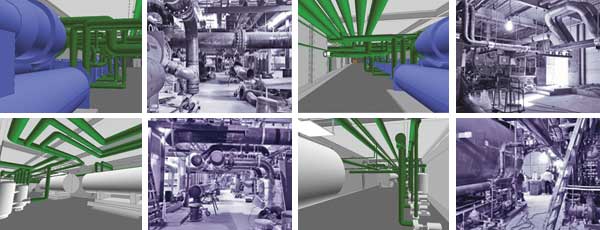BIM Promotes Sustainability
Walking the Walk
The major BIM developers are working hard to improve interoperability. Graphisoft, Bentley Systems, and Autodesk market architectural modelers and sibling MEP software, so the design team can work in compatible formats. These systems also export data to specialty analysis software such as IES, EnergyPlus, Ecotect, and Green Building Studio. This interoperability enables architects and engineers to work together earlier, and it helps architects understand the sustainability ramifications of design decisions, making it more likely a high-performing building will result. Still, interoperability is not perfect, and a lingua franca has emerged that further reduces barriers. NavisWorks, now owned by Autodesk, combines 3D data from virtually any format and produces a single model that simultaneously displays the work of all participating disciplines. Within that model, users can "walk through" the spaces in real time and identify potential conflicts between building systems. Importantly, even without access to the more complex design software that creates the model data, subcontractors can visualize how the building systems will go together.
Click on each image for an enlargement.

Constitution Center
Images courtesy SmithGroup |
Â
One example of how such coordination aids sustainability is provided by Autodesk itself. A new facility for the software giant has given them an opportunity to "walk the walk" of interoperability. Using IPD, they worked with two architecture firms, Anderson Anderson Architecture and HOK-a longtime national pioneer in both BIM and LEED-and with the construction firm DPR. They converted a 35,000-square-foot building in an historic district of San Francisco into offices and gallery spaces, dubbed "One Market."
The project is expected to receive a LEED-Platinum rating, thanks in part to points earned for reusing the existing structure. Before demolition, the entire space was laser-scanned, and the scan was placed in the model. The designers determined that about 75 percent of the ductwork would be reusable. For this project, model management fell to the builders. BIM engineer Christopher Rippingham received dozens of specialized models in many formats from architects, owner, engineers, and subcontractors, and he combined them in a master model using NavisWorks. The model was exported to Ecotect for lighting and daylighting analysis. And it was used to orient those performing the commissioning.
BIM was an important contributor to the final LEED status, but Rippingham imagines a day when it will do much more. "In Revit you can assign materials," he points out. "In the future, each material might ‘know' how much recycled material it contains so you can track how much recycled material is in the entire project." Similarly, he adds, you could track LEED points and carbon footprint while trying out design alternatives. "The technology is not quite there yet, but I foresee that in the future."
Support Software
That future might not be too far off. Webcor Builders and ClimateEarth, a company that does enterprise carbon accounting, are together developing software that will compute a carbon footprint during a building's design phase. They will add greenhouse-gas-related metrics to existing Vico Estimator databases to dynamically account for direct and indirect sources of emissions. As practitioners discover ways to benefit the environment using BIM-based interoperability, progress is also occurring at the institutional level. In March, a memorandum of understanding was announced that commits the USGBC and sister organizations in Australia and the United Kingdom to "develop common metrics to measure emissions of carbon dioxide equivalents from new houses and buildings." Look for carbon to play a more prominent role in design standards in the near future.
A vast amount of data associated with design projects is neither numeric nor geometric, but verbal communication in the form of reports, e-mail, specifications, and so on. A popular software system that organizes such project information is Newforma. During design review and construction administration, it streamlines work processes, tracking design decisions, potentially reducing errors and omissions. The newest edition, released in February 2009, facilitates the labor-intensive LEED documentation and tracks materials for certification. It also assists in documenting local product sourcing and project commissioning and manages the interactive communications among disciplines during IPD.
For specifiers, there is the new GreenFormat, a Construction Specifications Institute (CSI) format that organizes and displays the properties of products that affect sustainability. It does not certify greenness but instead relies on manufacturers' reports on those properties. A long list of characteristics includes third-party certification, chemical content, green practices of the manufacturer, life span of the product, and whether the material is reused, rapidly renewable, or includes recycled content. GreenFormat was begun by the CSI Sustainable Facilities Task Team and its ongoing development is supported by manufacturers, specifiers, environmental consultants, BuildingGreen LLC, and McGraw-Hill Construction's (publisher of GreenSource) Sweets.
Some manufacturers are taking their own initiatives. One example is a recent enhancement to USG Design Studio software, which helps architects design and specify USG products. The latest version includes a LEED reporting tool that creates a report of possible credits for the selected products.









